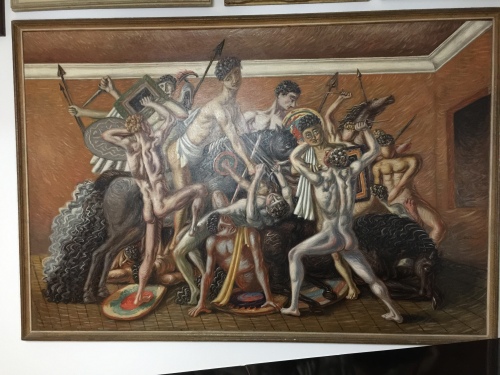Milan, 22 February 2017
We have just come back from a little holiday in Florence (ah, the joys of retirement! go where you like, when you like). Since neither my wife nor I had been back to Florence in the last 40-50 years (me, the former; my wife, the latter), we decided to celebrate her birthday by going on a little jaunt down there. We agreed that we wanted to visit at least the Uffizi galleries, to see what its new German director was up to, as well as Pitti Palace and its gardens, the Boboli gardens (neither of us having ever visited this complex, we discovered, after comparing notes). The rest would be up to chance and whatever took our fancy.
So decided, my wife took the management of the trip into her very capable hands. Having heard decades of horror stories about the queues to get into the Uffizi, she booked the tickets on-line, along with a time slot for the visit. To be on the safe side, she did the same for Pitti Palace and the Boboli gardens. She found a place to stay on the left bank of the Arno, a five-minute walk from Pitti Palace. And she booked tickets on the bus to get us there and back (much cheaper than the train; we are retirees, after all).
Thus prepared, we set off and spent five days in the city. We visited, in the following order, Pitti Palace; the Boboli gardens, the ticket for which included a visit to the gardens of the nearby Bardini Villa; the church of San Miniato; the Uffizi galleries; the church of Santo Spirito; the church of Santa Croce; the Cathedral, along with its Baptistery and museum; and, finally, on the way to catch the bus home, the church of San Lorenzo and its Medicean library. In between, we strolled through the streets of the city center, crossed the Arno several times a day using the Ponte Vecchio as well several of the other bridges which straddle the river, and last but not least enjoyed delectable dinners in a number of the trattorie located around where we were staying.
I will not bore readers with the details. Let me just point out what were some highlights for me, the things that come back to mind as I sit here writing this:
Bronzino’s Descent of Christ into Limbo, hanging in the church of Santa Croce.

A magnificent painting, with this luminously serene Christ pulling the dead from their graves. All that more wonderful knowing that this painting was terribly badly damaged in the big floods which struck Florence in November of 1966.
The mosaics in the dome of the Baptistery.

I was not expecting to see such magnificent late Medieval mosaics in that beating heart of the Renaissance which is Florence (the church of San Miniato also has a great mosaic in its apse).

A wooden crucifix carved by Michelangelo and tucked away in a corner chapel of the sacristy of the church of Santo Spirito.

Absent are the finely sculpted muscles, the blood and the gore, that you find in most crucifixes. Just a slim body hanging on the cross.
Donatello’s take on the prophet Jeremiah: a tough, uncompromising figure.

A copy can be seen on the Cathedral’s campanile, while the original is in the Museo del Duomo, the Cathedral Museum – a great museum, by the way, recently redesigned and now a really very pleasurable museum experience.

In the same museum, the unfinished Pietà by Michelangelo.

A statue which, as I have related in a previous post, transfixed me during me first visit to Florence forty years ago.
Botticelli’s Annunciation, in the Uffizi.

With such grace does Mary suggest that she is not worthy!
Of course, Botticelli’s Birth of Venus and his Spring, are also magnificent, but I have seen and re-seen them so many times now in a thousand pictures that my senses have been dulled towards them.
Also in the Uffizi, Piero della Francesca’s portrait of the Duke of Urbino and his wife

That Duke, what a wonderful, wonderful face!
Talking of faces, look at those of the shepherds in Hugo van der Goes’s Adoration of the Shepherds, also in the Uffizi.

Such rough and honest and simple faces!
The view of the Brunelleschi’s dome from the gardens of Villa Bardini.

We were taken completely by surprise as we rounded the corner of the villa and found Florence at our feet, with Brunelleschi’s dome soaring above the houses. As Leon Battista Alberti wrote in 1435, one year before the dome was finished, in his book De Pictura, “who is so hard or so jealous as to not praise Pippo [Brunelleschi] the architect upon seeing that structure so large, erected above the sky, broad enough to cover all of the Tuscan populace with its shade?”
And who is so hard or so jealous as not to praise Giorgio Vasari the painter, for his fresco of the last judgement which covers the inside of that dome?

_______________
Bronzino, Descent of Christ into Limbo: https://www.google.co.uk/amp/s/santacroceinflorence.wordpress.com/2014/03/18/bronzinos-1552-social-network-page/amp/
Floods, Florence: https://committeeforculturalpolicy.org/projects-for-50th-anniversary-of-florence-and-venice-floods/
Mosaics, Baptistery: https://commons.m.wikimedia.org/wiki/File:File-_The_mosaic_ceiling_of_the_Baptistery_in_Florence.jpg
Mosaic, San Miniato: https://www.flickr.com/photos/edk7/16383376970
Michelangelo, crucifix: https://www.visitflorence.com/itineraries-in-florence/fifteenth-century-wooden-sculpture.html
Donatello, the prophet Jeremiah: https://commons.m.wikimedia.org/wiki/File:Donatello,_geremia,_1427-36,_dal_lato_ovest_del_campanile_02.JPG
Museo del Duomo: http://viaggi.corriere.it/viaggi/eventi-news/firenze-inaugura-il-nuovo-museo-dellopera-del-duomo/
Michelangelo, Pietà: https://www.pinterest.com/pin/297589487853635778/
Botticelli, Annunciation: http://historylink101.com/art/Sandro_Botticelli/pages/26_Annunciation_jpg.htm
Piero della Francesca, Duke of Urbino and wife: http://www.abcfirenze.com/musei/MuseiFoto_i.asp?N=238&Foto=Uffizi-D22.jpg
Hugo van der Goes, Adoration of the Shepherds: http://www.artbible.info/art/large/111.html
View of the cathedral’s dome: https://www.pinterest.com/enamoradoitalia/villa-bardini-firenze-florence/
Vasari, Internal fresco of cathedral dome: https://it.m.wikipedia.org/wiki/Cupola_del_Brunelleschi

































_-_Archduke_Leopold_Wilhelm_of_Austria_in_his_Gallery_-_WGA22064.jpg)